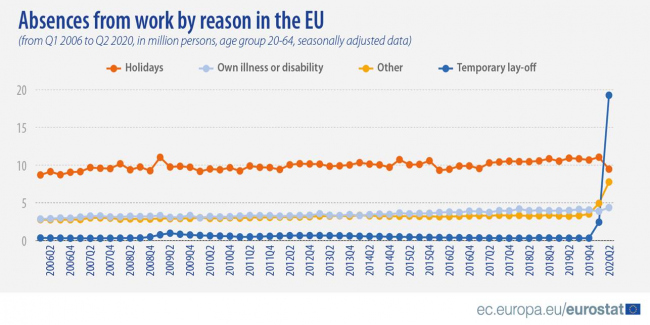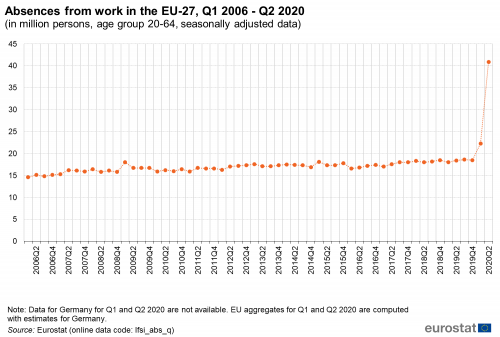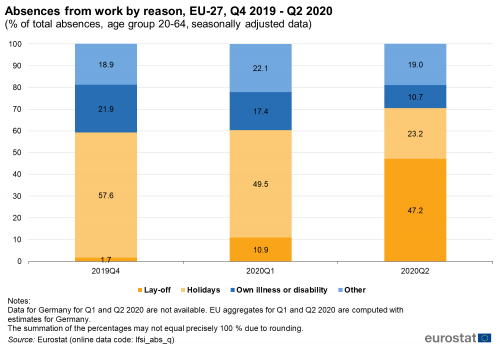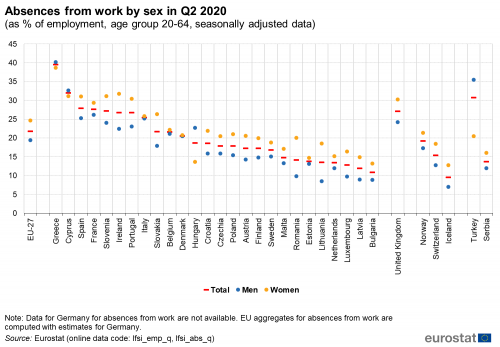Archive:Absences from work - quarterly statistics
Data extracted in October 2020
Planned article update: January 2021
Highlights
Absences from work can be classified in two groups: on one side, the planned, desired absences (e.g. annual holidays) and on the other side, the unplanned, undesired absences (e.g. illnesses, lay-offs). While the first type of absences could be easily “absorbed” by the companies, for example, by rescheduling the work priorities or recruiting temporary staff, the second type could lead to disruption of the production cycles and lead to material losses to both employers and employees.
It is worth noting that sometimes this distinction could be not so easy to make. Usually, annual leaves are guaranteed by the legislation, which may lead some employers to encourage their employees to take holidays when the enterprise is facing economic difficulties. This means that holidays sometimes may mask actual lay-offs.
The beginning of 2020 was marked by an outbreak of worldwide pandemic - COVID-19, leading almost all governments around the globe to take restrictive measures, of which the social distancing had a pivotal role. To prevent the spread of the virus and to ensure distancing of people, many businesses were temporarily shut down and many employees confined at their homes. Whereas worker protection laws may imply that employment, specifically of employees, will not be affected, at least at the beginning of the pandemic, one may expect over time a sharp rise of absences from work which falls under the aforementioned second category of undesired, unplanned absences.
This article aims to depict the absences from work in the European Union (EU) as a whole, for all EU Member States individually (except Germany for which data is not yet available), as well as for the United Kingdom, three EFTA countries (Iceland, Norway and Switzerland) and two candidate countries (Serbia and Turkey). Please note that the presented data is seasonally adjusted.
The article is a part of the online publication Labour market in the light of the COVID-19 pandemic - quarterly statistics.
Full article
Sharp increase in the number of absences in the first half of 2020
In the first half of 2020, absences from work recorded unprecedented levels since the beginning of the time series in 2006 (Figure 1), both in terms of an increase in a single quarter and of a volume in comparison to the whole time span. In the last quarter of 2019 (Q4 2019), 18.5 million people were absent from their jobs in the EU. This number reached 22.3 million in the beginning of 2020, i.e. the first quarter of the year (Q1 2020). In the second quarter of 2020 (Q2 2020), the number of absent from work people saw an even more striking increase, it almost doubled from the previous quarter and reached 40.9 million.
For reference, over the last fourteen years, until the end of 2019, the total number of absences from work varied from 14.6 to 18.6 million. Over this period, a couple of sharp peaks stand out. Namely, in the first quarter of 2009, when absences increased by 2.3 million in comparison to the fourth quarter of 2008 and accounted for 18.0 million. Also, in the first quarter of 2015, absences increased by 1.2 million, compared to the preceding quarter, and reached 18.1 million. However, the levels of absences from work in the first half of 2020 had been unparalleled for the period before.
The rise of absences from work in the first half of 2020 is primarily due to the increase of temporary lay-offs, as Figure 2 suggests. The levels of temporary lay-offs had been relatively stable in the period before the first quarter of 2020, with the exception of the first and the second quarter of 2009 when they rose consecutively by 0.3 and 0.2 million respectively, and their number never exceeded 0.5 million after the second quarter of 2015. However, in the first quarter of 2020, 2.4 million people were absent from work because of temporary lay-off, an increase of 2.1 million in comparison to the previous quarter. In the following quarter, this number increased even more sharply, by nearly eight times and reached 19.3 million.
The second-largest increase, during the first half of 2020, is observed for the number of people having “other” reason for being absent - from 3.5 million in the last quarter of 2019 to 4.9 and 7.8 million respectively for the first and the second quarter of 2020.
The number of people being absent from their work due to the other two reasons considered in Figure 2 developed differently in the first half of 2020. The number of people absent due to own illness or disability initially decreased from 4.1 in Q4 2019 to 3.9 million in Q1 2020. Then, it increased to 4.4 million in Q2 2020. The number of people not being at work due to holidays increased from 10.7 million at the end of 2019 (Q4 2019) to 11.0 million in the first quarter of 2020 and decreased back to 9.5 million during the following quarter (Q2 2020).
As shown in Figure 3, the temporary lay-off was the major reason for people to be absent from work during the second quarter of 2020 in EU-27. Absences due to lay-off represented 1.7 % of all absences in the last quarter of 2019. Hereafter, this share grew to 10.9 % in the first quarter and escalated to 47.2 % in the second quarter of 2020.
Looking at the distribution of the other reasons for absence during the last three quarters (up to quarter two 2020), it is visible that the rise of the share of lay-offs is accompanied by a decrease of the share of holidays as a reason for people not to be at work. Holidays represented the largest reason for absence in the fourth quarter of 2019 with 57.6 %, hereafter their share diminished to 49.5 % and 23.2 % in the first and the second quarter of 2020 respectively.
The share of people being away from their jobs due to their own illness or disability among all absences also shrank. Precisely, from 21.9 % in the fourth quarter of 2019, to 17.4 % in the first and 10.7 % in the second quarter of 2020.
Although the number of people having “other” reason for being absent from work increased substantially since the last quarter of 2019, their relative share among all absences remained relatively stable. It increased from 18.9 % to 22.1 % from the fourth quarter of 2019 to the first quarter of 2020. However, in the second quarter of 2020, with 19.0 %, it almost returned to its values from the last quarter of 2019.
Figure 4 compares overall absences from work as a percentage of employment in the last two quarters (the first and the second quarter of 2020). At EU level, absences accounted for 11.7 % of employment in the first quarter and reached 21.8 % in the second quarter of 2020, corresponding to an increase of 10.1 percentage points (p.p.). For comparison, the same share at the end of 2019 (quarter four) was 9.7 %.
During the second quarter of 2020, the lowest rates of absent from work employed people in the EU were recorded in Luxembourg (12.9 %), Latvia (12.0 %) and Bulgaria (10.9 %). In contrast, in 11 other Member States, absences accounted for more than one fifth of employment during the same period. Among these, on the one side of the scale were Denmark (20.6 %), Belgium (21.6 %) and Slovakia (21.7 %), and on the other side were Spain (27.9 %), Cyprus (32.0 %) and Greece (39.6 %).

Source: Eurostat (lfsi_emp_q), (lfsi_abs_q)
The share of absences among employed people increased in all EU Member States (with available data) from the first to the second quarter of 2020. However, the growth varied a lot: from +0.7 p.p. in Sweden, +0.8 p.p. in Lithuania and +2.1 p.p. in the Netherlands to +17.4 p.p. in Ireland, +20.1 p.p. in Cyprus and +31.5 p.p. in Greece.
Considering the sex differences (Figure 5), during the second quarter of 2020, at EU level, absent form work women were more than men, expressed as a percentage of employed: 24.6 % women compared to 19.4 % men. Looking into the Member States, the shares of absent from work men were largest in Greece (40.2 %), Cyprus (32.6 %) and France (26.1 %) and lowest in Latvia (9.0 %), Bulgaria (8.9 %) and Lithuania (8.5 %). The corresponding share for women was highest also in Greece (38.6 %), but in this case, followed by Ireland (31.7 %) and Slovenia (31.2 %). Employed women were least absent from work in Estonia (14.7 %), Hungary (13.7 %), and in Bulgaria (13.3 %).
The overall pattern across the Member States was the same as the EU, rates for women surpassed the rates for men. Most visibly, in Romania (20.1 % women versus 9.9 % men, 10.2 p.p. difference) and in Lithuania (18.6 % women versus 8.5 % men, 10.1 p.p. difference). The situation was the opposite only in three countries. The first two with largest total rates of absent from work people, Greece and Cyprus, where the shares of absent men exceeded slightly those of absent women, precisely with 1.6 p.p. on average for both countries. And also, in Hungary, where the difference between both sexes was more substantial: 22.7 % absent men compared to 13.7 % absent women (9.0 p.p. difference).
<sesection>
<sesection>
Absences from work due to holidays
People absent from work due to holidays were 9.5 million in the EU in the second quarter of 2020, corresponding to 5.1 % of the employed population (Figure 6). This rate ranged from more than 7 % in France (8.6 %), Finland (7.8 %) and Sweden (7.2 %) to less than 3 % in Poland (2.9 %), Lithuania (2.6 %), Luxembourg (2.0 %) and Malta (1.1 %).
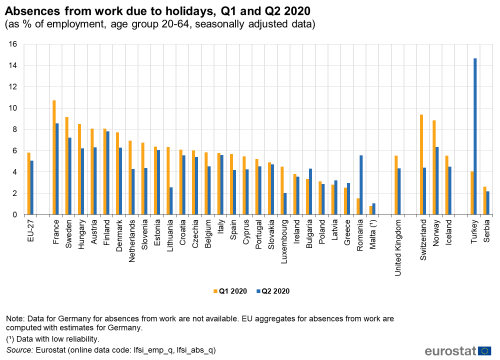
Source: Eurostat (lfsi_emp_q), (lfsi_abs_q)
Considering the development over the first half of 2020 at EU level, the share of people absent due to holidays experienced a decrease of -0.7 p.p. from the first to the second quarter of the year (from 5.8 % to 5.1 %). The majority of Member States (21 out of 26 countries for which data are available) also saw this rate falling over the same period with decreases ranging from -0.2 p.p in Ireland, Italy, Slovakia and Poland to -2.5 p.p. in Luxembourg, -2.6 p.p. in the Netherlands and -3.7 p.p. in Lithuania. In five other Member States, the share of people being on holidays increased from the first to the second quarter of the year, namely in Malta, Latvia and Greece (for all +0.4 p.p. increase on average), and also in Bulgaria (+1.0 p.p.) and Romania (+4.1 p.p.).
Absences from work due to own illness or disability
Own illness or disability was the reason for 4.4 million people in the EU to be absent from work in the second quarter of 2020. This represented 2.3 % of the employed population (Figure 7). Considering the same quarter, the share of absences from work because of this reason was the largest in Spain (4.1 %), France (3.9 %), Portugal (3.8 %) and Sweden (3.6 %), and the smallest in Cyprus, Italy, Bulgaria and Greece, where corresponded to less than 1 % of employment.
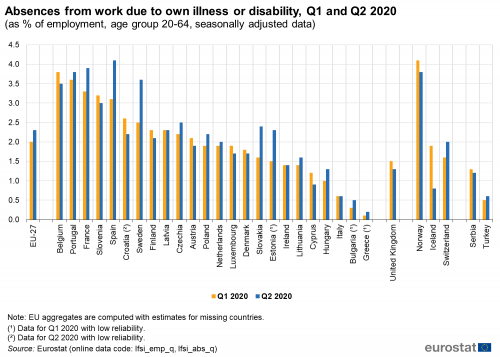
Source: Eurostat (lfsi_emp_q), (lfsi_abs_q)
From the first to the second quarter of 2020 the share of employed people who were absent from work due to own illness or disability increased from 2.0 % to 2.3 % (+0.3 p.p.) at EU level. In three EU countries, namely Latvia (2.3 %), Ireland (1.4 %) and Italy (0.6 %), it remained stable in the first two quarters of 2020. In eight other Member States, it went slightly down, with a decrease ranging from -0.1 p.p. in Denmark to -0.4 p.p. in Croatia. The greatest number of EU states for which data are available, precisely 13, encountered an increase of people absent because of their own illness or disability as a share of employment. This was the case in the Netherlands and Greece which experienced the lowest increase with +0.1 p.p. for both. On the other side of the spectrum, with larger growth, were Spain and Sweden, where the share of people absent from work because of their own illness or disability increased with +1.0 p.p. and +1.1 p.p. respectively.
Absences from work due to temporary lay-off
At EU-level, in the second quarter of 2020, 19.3 million people were absent from work due to temporary lay-off, corresponding to 10.3 % of the employed population (Figure 8). For comparison, this share was 1.3 % in the first quarter of the year. Please note that in this article temporary lay-off should not be understood as a dismissal but as temporarily leave due to technical or economic reasons.
The share of people absent from work due to temporary lay-off varied significantly across EU countries (with available data) in the second quarter of 2020. The Member State which registered the highest share was Cyprus, with 26.0 % of absence due to temporary lay-off among the employed people, followed by Greece (21.4 %), Spain (18.3 %) and Slovenia (15.8 %). In contrast, the Netherlands, Sweden, Lithuania and Czechia recorded shares of less than 2 %. For benchmark, in the fourth quarter of 2019, i.e. the quarter before the outbreak of the COVID pandemic, there is no Member State with available data, where people absent due to lay-off represented more than 1 % of employment.
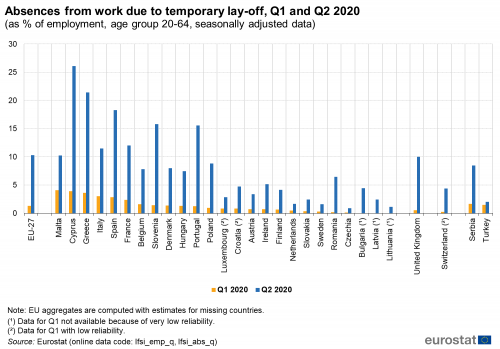
Source: Eurostat (lfsi_emp_q), (lfsi_abs_q)
The countries, which recorded the highest shares of temporary lay-offs among employed in the EU, recorded also the highest increase of these shares from the first to the second quarter of 2020. In Spain temporary lay-offs went up with +15.4 p.p., in Greece with +17.8 p.p. and in Cyprus with +22.1 p.p. There is not a single Member State with data available for both the first and the second quarter of 2020, which marked a decrease of the shares of temporary lay-offs between these periods. However, some countries experienced a relatively more moderate increase, namely Sweden (+1.3 p.p.), the Netherlands (+1.2 p.p.) and Czechia (+0.8 p.p.).
It is worth mentioning that, although the highest increases of temporary lay-offs as a share of employment, were encountered in Spain, Greece and Cyprus, in other three Member States, workers being absent because of this reason enlarged the most in terms of their absolute number between the first two quarters of 2020. These were Romania, Portugal and Slovenia, where people not being at their jobs due to temporary lay-off increased respectively: from 16.3 to 525.8 thousand (Romania), from 57.8 to 694.0 thous. (Portugal) and from 13.5 to 149.1 thous. (Slovenia). This suggests, that the employment in the latter three mentioned countries, had been more able to take over the growth of lay-offs in comparison with Spain, Greece and Cyprus.
Source data for tables and graphs
Data sources
All figures in this article are based on seasonally adjusted quarterly results from European labour force survey (EU-LFS).
Source: The European Union labour force survey (EU-LFS) is the largest European household sample survey providing mostly quarterly and annual results on labour participation of people aged 15 and over as well as on persons outside the labour force. It covers residents in private households. Conscripts in military or community service are not included in the results. The EU-LFS is based on the same target populations and uses the same definitions in all countries, which means that the results are comparable between countries.
European aggregates: EU refers to the sum of EU-27 Member States. If data are unavailable for a country, the calculation of the corresponding aggregates is computed with estimates. Such cases are indicated.
Country note: Due to technical issues with the introduction of the new German system of integrated household surveys, including the Labour Force Survey (LFS), the figures for Germany for the first and second quarter of 2020 are not direct estimates from LFS microdata, but based on a larger sample including additional data from other integrated household surveys. For more information, see here. The figures for Germany are included in the EU aggregates; however, they are not available separately.
The notion of temporary absence from work refers to situations in which a period of work is interrupted by a period of absence. This implies that persons are generally to be considered as having been temporarily absent from work and therefore employed, if they had already worked at their current activity and were expected to return to their work after the period of absence. Persons without work who had made arrangements to take up paid employment or to engage in some self-employment activity at a date subsequent to the reference period, but who had not yet started work, are not to be considered as temporarily absent from work.
This article refers to the following reasons for absence from work: temporary lay-off, holidays, own illness or disability and other. Absence from work is classified as a “temporary lay-off” if it is due to slack work for technical or economic reasons; this category also includes absences due to difficulties such as plant breakdown or materials shortage. Those whom written or unwritten contract of employment, or activity, has been suspended by the employer are also considered as employed and absent from work due to temporary lay-off if they have an assurance of return to work within a period of 3 months or receive at least 50 % of their wage or salary from their employer. “Own illness or disability” includes own illness, injury or temporary disability. The category “other” encompasses absences due to bad weather, labour dispute, school education or training, maternity leave, parental leave, compensation leave and other personal or family reasons.
For more information on absences from work, please consult pages 22 to 28 from EU Labour Force Survey Explanatory Notes
Context
The COVID-19 virus hit Europe in January and February 2020, with the first cases confirmed in Spain, France and Italy. COVID-19 infections have now been diagnosed in all European Union (EU) Member States.
To fight the pandemic, EU Member States have taken a wide variety of measures.
From the second week of March, most countries closed retail shops apart from supermarkets, pharmacies and banks. Bars, restaurants and hotels have also been closed. In Italy and Spain, non-essential production was stopped and several countries imposed regional or even national lock-down measures which further stifled the economic activities in many areas.
In addition, schools were closed, public events were cancelled and private gatherings (with numbers of persons varying from 2 to 50) were banned in most Member States.
The large majority of the prevention measures were taken during mid-March 2020 and most of the prevention measures and restrictions were kept for the whole of April and May 2020.
The first quarter 2020 is consequently the first quarter in which the labour market across the EU has been affected by COVID-19 measures taken by the Member States.
Employment and unemployment as defined by the ILO concept are, in this particular situation, not sufficient to describe the developments taking place in the labour market. In this first phase of the crisis, active measures to contain employment losses led to absences from work rather than dismissals, and individuals could not search for work or were not available due to the containment measures, thus not counting as unemployed.
Direct access to
<maintables>
Main tables
<maintables>
